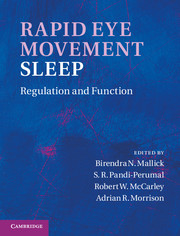Book contents
- Frontmatter
- Contents
- Contributors
- Preface
- Acknowledgments
- Organization
- Section I Historical context
- Section II General biology
- Section III Neuronal regulation
- Section IV Neuroanatomy and neurochemistry
- 19 Aminergic influences in the regulation of basic REM sleep processes
- 20 REM sleep regulation by cholinergic neurons: highlights from 1999 to 2009
- 21 GABAergic modulation of REM sleep
- 22 Glutamatergic regulation of REM sleep
- 23 The role of tuberomammillary nucleus histaminergic neurons, and of their receptors, in the regulation of sleep and waking
- 24 Hypocretinergic system: role in REM-sleep regulation
- 25 Neuropeptides and REM sleep
- 26 Adenosine and glycine in REM-sleep regulation
- 27 Changes in neurotransmitter levels in relation to REM sleep for its regulation
- 28 Pontine areas inhibiting REM sleep
- 29 Neuronal models of REM-sleep control: evolving concepts
- Section V Functional significance
- Section VI Disturbance in the REM sleep-generating mechanism
- Index
- Plate section
- References
25 - Neuropeptides and REM sleep
from Section IV - Neuroanatomy and neurochemistry
Published online by Cambridge University Press: 07 September 2011
- Frontmatter
- Contents
- Contributors
- Preface
- Acknowledgments
- Organization
- Section I Historical context
- Section II General biology
- Section III Neuronal regulation
- Section IV Neuroanatomy and neurochemistry
- 19 Aminergic influences in the regulation of basic REM sleep processes
- 20 REM sleep regulation by cholinergic neurons: highlights from 1999 to 2009
- 21 GABAergic modulation of REM sleep
- 22 Glutamatergic regulation of REM sleep
- 23 The role of tuberomammillary nucleus histaminergic neurons, and of their receptors, in the regulation of sleep and waking
- 24 Hypocretinergic system: role in REM-sleep regulation
- 25 Neuropeptides and REM sleep
- 26 Adenosine and glycine in REM-sleep regulation
- 27 Changes in neurotransmitter levels in relation to REM sleep for its regulation
- 28 Pontine areas inhibiting REM sleep
- 29 Neuronal models of REM-sleep control: evolving concepts
- Section V Functional significance
- Section VI Disturbance in the REM sleep-generating mechanism
- Index
- Plate section
- References
Summary
Summary
Sleep is a process occurring in all living animals. Although it is still controversial whether insects and other animals sleep alike; there is no doubt that they rest, as many studies in Drosophila melanogaster have shown. In this context, several seminal studies have documented species-dependent variations in sleep patterns. These findings along with obvious non-learned characteristics of sleep in general, such as the total time of sleep, the alternating NREM–REM sleep pattern, among many others, suggest strong regulation by genes. Clearly, the way genes may influence sleep physiology is via proteins. Hence, the importance of proteins in the regulation of sleep is observed in every minute event occurring to trigger or to maintain sleep. In this chapter we discuss families of proteins that are grouped by their effect on food ingestion, immunological response, trophic activity, and intracellular signaling, all of them affecting the sleep–waking cycle. Although we do not fully discuss the mechanisms of action, we put our effort in highlighting their effects on sleep. Along with the proteins and their effects we have listed those genes encoding them. We also show examples of proteins and the way they affect sleep. Hence, we hope that the overall message that readers will gather from this chapter is the importance of several proteins in the regulation of sleep. Also, by observing the effects of each family of proteins we can infer at least some functions of sleep and, finally, that sleep is a multigenic trait.
- Type
- Chapter
- Information
- Rapid Eye Movement SleepRegulation and Function, pp. 247 - 255Publisher: Cambridge University PressPrint publication year: 2011



